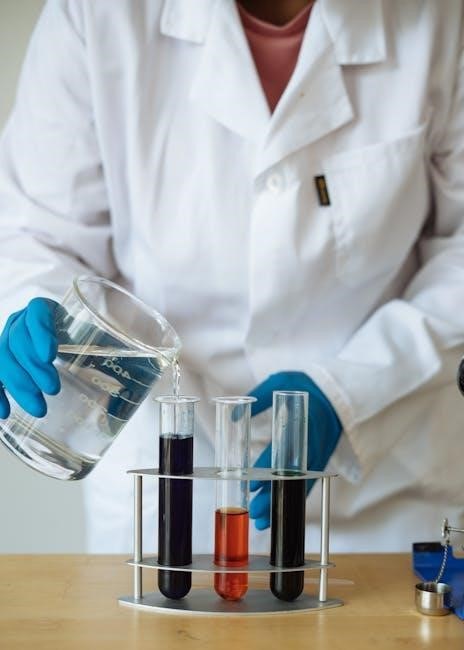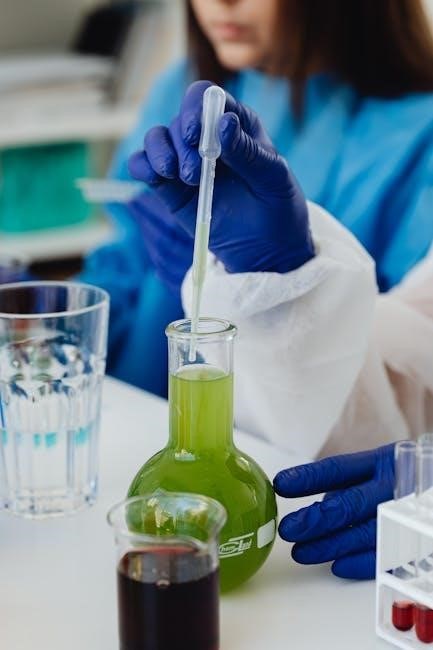Chemical reactions involve the transformation of reactants into products, forming the cornerstone of chemistry. Understanding reaction types, such as synthesis and combustion, is essential for mastering chemical principles. Study guides and practice problems provide foundational knowledge, enabling students to classify and predict reactions, while examples and detailed solutions enhance comprehension and application.
Definition and Importance of Chemical Reactions
Chemical reactions are processes where substances, known as reactants, transform into new substances called products. These reactions involve the breaking and forming of chemical bonds, resulting in changes in matter. Understanding chemical reactions is fundamental to chemistry, as they explain how elements interact and form compounds. Study guides emphasize their importance in predicting outcomes, balancing equations, and applying concepts to real-world scenarios. Mastering reactions is crucial for fields like medicine, engineering, and environmental science, where chemical processes drive innovation and problem-solving.
Key Terms: Reactants, Products, and Chemical Equations
In chemical reactions, reactants are the substances consumed, while products are the new substances formed. A chemical equation represents these transformations, with reactants on the left and products on the right, separated by an arrow. Coefficients indicate the number of molecules involved, and subscripts show atom ratios. Balancing equations ensures mass conservation. Understanding these terms is critical for analyzing and predicting reaction outcomes, as they form the foundation of chemical stoichiometry and reaction mechanisms in study guides and academic resources.

Types of Chemical Reactions
Chemical reactions are classified into synthesis, decomposition, single-replacement, double-replacement, and combustion reactions. Each type follows distinct patterns, guiding the transformation of reactants into products in study guides.
Synthesis Reactions
Synthesis reactions involve the combination of two or more reactants to form a single product. They are also known as combination reactions. For example, hydrogen gas reacting with oxygen to form water is a classic synthesis reaction. These reactions are fundamental in chemistry, as they demonstrate how elements bond to create compounds. Study guides emphasize recognizing synthesis reactions by their characteristic format: A + B → AB. Practicing these reactions helps students understand basic chemical bonding and stoichiometry, essential for advanced topics in chemistry.
Decomposition Reactions
Decomposition reactions involve a single compound breaking down into two or more simpler substances. They are the reverse of synthesis reactions. A general format is AB → A + B. Examples include hydrogen peroxide decomposing into water and oxygen: 2H₂O₂ → 2H₂O + O₂. These reactions are crucial for understanding chemical breakdown processes. Study guides often highlight decomposition reactions with practice problems, enabling students to identify and write balanced equations. Recognizing these reactions is essential for mastering chemical transformations and their applications in various fields.
Single-Replacement Reactions
Single-replacement reactions involve one element displacing another in a compound, following the format A + BC → AC + B. Examples include zinc reacting with hydrochloric acid: Zn + 2HCl → ZnCl₂ + H₂. These reactions demonstrate how elements interact based on reactivity. Study guides often provide practice problems to identify and balance such reactions. Understanding single-replacement reactions is key to grasping chemical substitution processes and their applications in laboratory and industrial settings. They highlight the role of reactivity series in predicting reaction outcomes, making them fundamental in chemistry education. Balancing these equations is a core skill for students. These reactions are essential for understanding chemical substitution processes and their applications in laboratory and industrial settings. They highlight the role of reactivity series in predicting reaction outcomes, making them fundamental in chemistry education. Balancing these equations is a core skill for students.
Double-Replacement Reactions
Double-replacement reactions occur when two ionic compounds exchange ions to form two new compounds. The general form is AB + CD → AD + CB. For example, sodium sulfate reacts with barium chloride to produce barium sulfate precipitate and sodium chloride. These reactions often result in the formation of a precipitate, gas, or water. Identifying such reactions involves recognizing ionic compounds and their potential to swap ions. Study guides often include practice problems to master this type of reaction, emphasizing solubility rules and stoichiometry. Balancing these equations is a key skill for chemistry students.
Combustion Reactions
Combustion reactions involve a substance reacting with oxygen, typically producing heat and light. The general form is fuel + oxygen → carbon dioxide + water. For example, methane burns to form CO₂ and H₂O. These reactions are exothermic and often used for energy production. Combustion of fossil fuels releases energy but also contributes to CO₂ emissions. Understanding combustion is crucial for industries like energy and transportation. Balancing combustion equations is a key skill in chemistry, as it involves stoichiometry and elemental analysis. Practice problems help students master this fundamental reaction type.

Balancing Chemical Equations
Balancing chemical equations ensures the number of atoms for each element is equal on both sides. This process involves adjusting coefficients to achieve equilibrium. Steps include identifying unbalanced atoms, starting with the most complex molecules, and verifying the balance. Properly balanced equations are essential for stoichiometry and understanding reaction ratios. Examples like 2H₂ + O₂ → 2H₂O demonstrate this principle, ensuring accurate chemical representations.
Steps to Balance Chemical Equations
To balance chemical equations, start by identifying the number of atoms for each element on both sides. Assign coefficients to the most complex molecules first, then adjust systematically. Ensure the smallest whole numbers are used to maintain simplicity. Verify the equation by counting atoms on both sides to confirm balance. This method ensures accuracy and clarity in representing chemical reactions. Practice problems and detailed examples, like balancing H₂ and O₂ to form H₂O, help master this essential skill.
Examples of Balanced Equations
Balanced chemical equations are crucial for accurately representing reactions. For instance, the synthesis of water: 2H₂ + O₂ → 2H₂O. Decomposition is shown in 2H₂O → 2H₂ + O₂. Single-replacement reactions, like Zn + 2HCl → ZnCl₂ + H₂, and double-replacement reactions, such as Na₂SO₄ + BaCl₂ → BaSO₄ + 2NaCl, demonstrate balanced transformations. Combustion, like C + O₂ → CO₂, highlights elemental reactions. These examples illustrate the application of balancing principles, aiding in understanding and practice.

Chemical Equation Terminology
Chemical equations use symbols, numbers, and arrows to represent reactions; Reactants and products are substances involved, while coefficients and states of matter provide clarity and detail.
Coefficients and Their Role
Coefficients are numbers placed in front of chemical formulas in an equation. They indicate the number of molecules (or moles) of a reactant or product involved. Coefficients help balance the equation by ensuring equal numbers of atoms on both sides. For example, in 2H₂ + O₂ → 2H₂O, the coefficient 2 shows two molecules of hydrogen and water. If a coefficient is 1, it is often omitted. Coefficients also represent mole ratios, which are critical for stoichiometric calculations. They are essential for accurately describing and quantifying chemical reactions.
Catalysts and Their Function
Catalysts are substances that accelerate chemical reactions without being consumed. They lower the activation energy, enabling reactions to proceed faster or under milder conditions. Unlike reactants, catalysts remain unchanged at the end of a reaction. For example, in the decomposition of hydrogen peroxide, ferric ion acts as a catalyst. Catalysts are crucial in industrial processes, such as in catalytic converters and chemical synthesis. They enhance reaction efficiency and selectivity, making them vital in both laboratory settings and large-scale production. Their role is to speed up reactions, reducing time and energy requirements.
States of Matter in Equations
In chemical equations, the physical state of substances is indicated using symbols: (s) for solids, (l) for liquids, (g) for gases, and (aq) for aqueous solutions. These notations are essential for accurately describing reactants and products. For example, Zn(s) indicates solid zinc, while H2(g) represents hydrogen gas. States of matter are crucial for determining reaction conditions and solubility. Aqueous solutions involve substances dissolved in water, such as NaCl(aq). Accurately specifying states ensures clarity and precision in chemical equations, aiding in predicting and understanding reaction outcomes.
Thermodynamics Basics
Thermodynamics explores energy changes in chemical reactions, determining if they release (exothermic) or absorb (endothermic) energy, crucial for understanding reaction spontaneity and energy transformations.
Exothermic vs. Endothermic Reactions
Exothermic reactions release energy, often in the form of heat, while endothermic reactions absorb energy. Exothermic reactions are typically spontaneous, releasing energy into the surroundings, whereas endothermic reactions require energy input to proceed. Examples of exothermic reactions include combustion and neutralization, while endothermic reactions, such as photosynthesis, absorb energy. Understanding the energy flow in these reactions is crucial for predicting reaction outcomes and controlling chemical processes. Study guides often emphasize these concepts, providing examples and diagrams to illustrate energy changes.
Activation Energy and Reaction Rate
Activation energy is the minimum energy required for reactants to initiate a chemical reaction. A higher activation energy means a slower reaction rate, as fewer particles have enough energy to overcome the barrier. Factors like temperature, catalysts, and surface area can influence reaction rates by altering the frequency and energy of particle collisions. Catalysts lower activation energy, speeding up reactions without being consumed. Understanding these concepts helps predict reaction efficiency and control processes. Study guides often include diagrams and examples to illustrate how activation energy affects reaction dynamics and rates.

Practice Problems and Solutions
Practice problems and solutions are essential for mastering chemical reactions. Interactive questions with detailed solutions help students understand reaction types and stoichiometry, enhancing their problem-solving skills effectively.
Identifying Reaction Types
Identifying reaction types is a fundamental skill in chemistry. Common types include synthesis, decomposition, single-replacement, double-replacement, and combustion reactions. Synthesis reactions involve combining reactants to form a single product, while decomposition reactions break down a compound into simpler substances. Single-replacement reactions involve one element displacing another, and double-replacement reactions swap ions between two compounds. Combustion reactions typically involve a substance reacting with oxygen to produce heat and light. By analyzing reactants and products, students can classify reactions accurately, enhancing their understanding of chemical processes through guided practice problems and examples.
Stoichiometry and Limiting Reactants
Stoichiometry involves calculating the molar ratios of reactants and products in chemical reactions. Identifying the limiting reactant is crucial, as it determines the maximum amount of product that can be formed. By comparing mole ratios to the balanced equation, students can pinpoint the limiting reactant and calculate theoretical yields. Practice problems often involve solving for missing quantities and understanding concepts like percent yield. This skill is vital for laboratory applications and chemical engineering, requiring precise calculations and a deep understanding of reaction dynamics. Examples and detailed solutions help reinforce these principles effectively.
